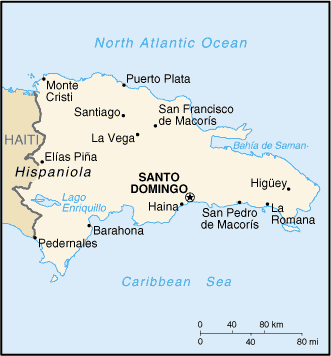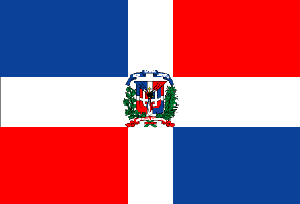
|
Dominican Republic
Background:
A legacy of unsettled, mostly non-representative, rule for much of the 20th
century was brought to an end in 1996 when free and open elections ushered in a
new government.
Location:
Caribbean, eastern two-thirds of the island of Hispaniola, between the
Caribbean Sea and the North Atlantic Ocean, east of Haiti.
Area: Total: 48,730 sq km, land: 48,380 sq km, water: 350 sq km.
Area - comparative: slightly more than twice the size of New Hampshire
Land boundaries: Total: 360 km, border countries: Haiti 360 km.
Coastline: 1,288 km.
Climate and Terrain:
Climate: Tropical maritime; little seasonal temperature variation; seasonal
variation in rainfall.
Terrain: Rugged highlands and mountains with fertile valleys interspersed.
Elevation extremes: Lowest point: Lago Enriquillo -46 m, highest point: Pico
Duarte 3,175 m.
Natural resources: Nickel, bauxite, gold, silver.
People:
Population: 8,721,594.
Ethnic groups: White 16%, black 11%, mixed 73%.
Religions: Roman Catholic 95%.
Languages: Spanish.
Government:
Government type: Representative democracy.
Capital: Santo Domingo.
Independence: 27 February 1844 (from Haiti).
Economy overview:
The Dominican economy experienced dramatic growth over the last decade, even
though Hurricane Georges hit the economy hard in 1998. Although the country has
long been viewed primarily as an exporter of sugar, coffee, and tobacco, in
recent years the service sector has overtaken agriculture as the economy's
largest employer, due to growth in tourism and free trade zones. The country
suffers from marked income inequality; the poorest half of the population
receives less than one-fifth of GNP, while the richest 10% enjoy 40% of
national income. A US $500 million foreign bond issue in September 2001 will
contribute to increased public investment spending.
GDP - composition by sector: Agriculture: 11.1%, industry: 34.1%, services:
54.8%.
Statistics:
Telephones - main lines in use: 709,000.
Telephones - mobile cellular: 130,149.
Radio broadcast stations: AM 120, FM 56.
Radios: 1.44 million.
Television broadcast stations: 25.
Televisions: 770,000.
Internet users: 25,000.
Railways: Total: 757 km.
Highways: Total: 12,600 km, paved: 6,224 km, unpaved: 6,376 km.
Airports: 29, with paved runways: 13, with unpaved runways: 16.
Return to Visiting Locations
|

